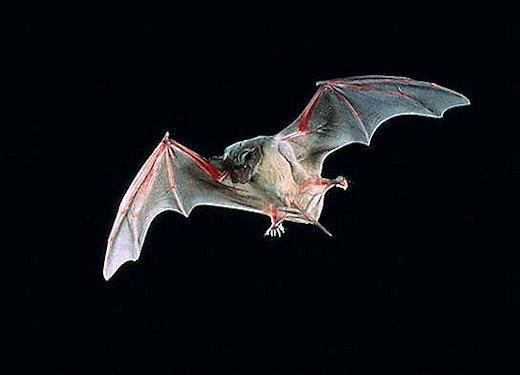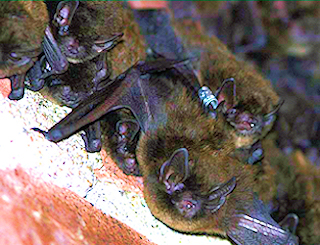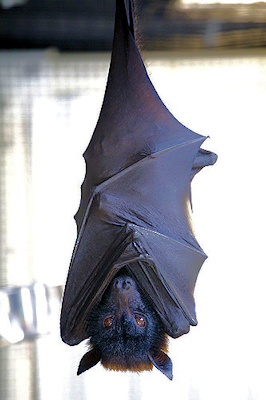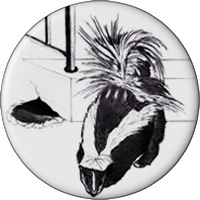Bats
Conservation and Public Education
Despite their ecological value, bats are relentlessly and unjustifiably persecuted. Bats are often killed because they live near people who needlessly fear them. These actions emphasize the need to educate the public on the reasons for bat conservation and why it is important to use safe, non-destructive methods to alleviate conflicts between people and bats. General sources of information on bats include universities, government environmental conservation and health departments, and Bat Conservation International (Austin, Texas). Except where control is necessary, bats should be appreciated from a distance and not disturbed.
Identification
 Bats, the only mammals that truly fly, belong to the order Chiroptera, meaning hand wing. Their ability to fly, their secretiveness, and their nocturnal habits have contributed to bat folklore, superstition, and fear. They are worldwide in distribution and include about 900 species, second in number only to Rodentia (the rodents) among the mammals.
Bats, the only mammals that truly fly, belong to the order Chiroptera, meaning hand wing. Their ability to fly, their secretiveness, and their nocturnal habits have contributed to bat folklore, superstition, and fear. They are worldwide in distribution and include about 900 species, second in number only to Rodentia (the rodents) among the mammals.
Bats congregating in groups are called colonial bats; those that live a lone existence are known as solitary bats.
The colonial species most often encountered in and around human buildings in the Calgary area are the little brown bat, (Myotis lucifugus) and the big brown bat (Eptesicus fuscus).
Solitary bats typically roost in tree foliage or under bark, but occasionally are found associated with buildings, some only as transients during migration. These include the silver-haired bat (Lasionycteris noctivagans), and the hoary bat(Lasiurus cinereus).
Colonial Bats
Little brown bat (Myotis lucifugus)
Recognition
Forearm: 3.4 to 4.1 cm (1.34 to 1.61 inches)
Wingspan: 22.9 to 26.9 cm (9.02 to 10.59 inches)
Ears: 1.4 to 1.6cm 90.55 to 0.63 inches)
Foot: approximately 1.0 cm (0.39 inches); long hairs on toes extend beyond claws.
Color
Pale tan through reddish brown to dark brown, depending on geographic location. The species is a rich dark brown in the eastern United States and most of the west coast. Fur is glossy and sleek.
Habits
This is one of the most common bats found in and near buildings, often located near a body of water where they forage for insect prey. Summer colonies are very gregarious, commonly roosting in dark, hot attics and associated roof spaces where maternity colonies may include hundreds to a few thousand individuals. Colonies may also form beneath shingles and siding, in tree hollows, beneath bridges, and in caves. Litter size is 1 in the Northeast; twins occasionally occur in some other areas. The roost is often shared with the big brown bat (E. fuscus) though the latter is less tolerant of high temperatures. Separate groups of males tend to be smaller and choose cooler roosts within attics, behind shutters, under tree bark, in rock crevices, and within caves. In the winter, little brown bats in the eastern part of their range abandon buildings to hibernate in caves and mines. Such hibernacula may be near summer roosts or up to a few hundred kilometres away. Little is known of the winter habits of M. lucifugus in the western United States and Canada. The life span of little brown bats has been established to be as great as 31 years. The average life expectancy, however, is probably limited to only a few years.
Big brown bat (Eptesicus fuscus)
Recognition
Forearm: 4.2 to 5.1 cm (1.65 to 2.01 inches)
Wingspan: 32.5 to 35.0 cm (12.80 to 13.78 inches)
Ears: with rounded tragus
Color
From reddish brown, copper coloured, to a dark brown depending on geographic location. This is a large bat without distinctive markings.
Habits
 This hardy, rather sedentary species appears to favour buildings for roosting. Summer maternity colonies may include a dozen or so and up to a few hundred individuals, roosting behind chimneys, in enclosed eaves, in hollow walls, attics, barns, and behind shutters and unused sliding doors. They also form colonies in rock crevices, beneath bridges, in hollow trees, and under loose bark. Litter size from the Rockies westward is 1 young.
This hardy, rather sedentary species appears to favour buildings for roosting. Summer maternity colonies may include a dozen or so and up to a few hundred individuals, roosting behind chimneys, in enclosed eaves, in hollow walls, attics, barns, and behind shutters and unused sliding doors. They also form colonies in rock crevices, beneath bridges, in hollow trees, and under loose bark. Litter size from the Rockies westward is 1 young.
Males typically roost in smaller groups or alone during the summer. The big brown bat is one of the most widely distributed of bats in the United States and is probably familiar to more people than any other species. This is partially due to its large, easy to observe size, but also to its ability to overwinter in buildings (attics, wall spaces, and basements). Its close proximity to humans, coupled with its tendency to move about when temperature shifts occur, often brings this bat into human living quarters and basements in summer and winter. Big browns also hibernate in caves, mines, storm sewers, burial vaults, and other underground harbourage. While E. fuscus will apparently travel as far as 241 km (150 miles) to hibernacula, the winter quarters of the bulk of this species are largely unknown. Big brown bats may live as long as 18 years.
Solitary Bats
Silver-haired bat (Lasionycteris noctivagans)
Recognition
Forearm — 1.46 to 1.73 inches (3.7 to 4.4 cm)
wingspan — 10.63 to 12.20 inches (27.0 to 31.0 cm)
ears — short, rounded, hairless
tail membrane — upper surface is sparsely furred on the anterior onehalf.
Color
Usually black with silver-tipped fur; some individuals with dark brown, yellowish-tipped fur. Confusion sometimes occurs with the larger hoary bat (Lasiurus cinereus), which has patches of hair on the ears and wings, heavy fur on the entire upper surface of the tail membrane, and has a distinctive throat “collar.”
Habits
The silver-haired bat roosts in a wide variety of harbourages. A typical roost might be behind loose tree bark. Other sites include tree hollows and bird nests. This species is solitary except when with young. Additionally, there are unconfirmed reports that it is sometimes colonial and may roost in and on buildings. The litter size is 2. The sexes segregate through much of the summer range. L. Noctivagans hibernates in tree crevices, under loose bark, in buildings, hulls of ships, rock crevices, silica mines, and non-limestone caves. It also may migrate, during which time it is encountered in buildings (they favour open sheds, garages, and outbuildings rather than enclosed attics), in lumber piles, and on ships at sea.
Hoary bat (Lasiurus cinereus)
Recognition
Forearm — 4.6 to5.8 cm (1.81 to 2.28 inches)
Wingspan — 38.0 to 41.0 cm (14.96 to 16.14 inches)
Ears — relatively short, rounded, edged with black, and with fur
Tail membrane — completely furred on upper surface
Color
Dark, but many hairs are tipped in white, giving it a frosted appearance. This bat also has a yellowish or orangish throat “collar.” Confusion may sometimes occur with the much smaller silver-haired bat (Lasionycteris noctivagans), which lacks the fur patches and markings on the ears, markings on the throat, and has a tail membrane that is only lightly furred on the upper surface.
Habits
Hoary bats generally spend summer days concealed in tree foliage (often in evergreens), rarely enter houses, and are not commonly encountered by people. L. cinereus at their day roosts are usually solitary except when with young. The litter size is 2. The sexes segregate through most of the summer range. This is one of the largest bats in North America, a powerful flier, and an accomplished migrant. Records indicate that some L. cinereus may hibernate in northern parts of their range.
Food Habits
Bats in North America are virtually all insectivorous, feeding on a variety of flying insects (exceptions among house bats were noted previously). Many of the insects are harmful to humans. While there must be some limitations based on such factors as bats’ body size, flight capabilities, and jaw opening, insectivorous bats apparently consume a wide range of prey. The little brown bat’s diet includes mayflies, midges, mosquitoes, caddis flies, moths, and beetles. It can consume insects equal to one-third of its body weight in ½ hour of foraging. The big brown bat may fill its stomach in about 1 hour (roughly 2.7 g/hr [0.1 ounce per hour]) with prey including beetles, moths, flying ants, true bugs, mayflies, caddis flies, and other insects. The nightly consumption of insects by a colony of bats can be extremely large.
General Biology, Reproduction, and Behaviour
Most North American bats emit high frequency sounds (ultrasound) inaudible to humans and similar to sonar, in order to avoid obstacles, locate and capture insect prey, and to communicate. Bats also emit audible sounds that may be used for communication between them.
Bats generally mate in the fall and winter, but the female retains the sperm in the uterus until spring, when ovulation and fertilization take place. Pregnant females may congregate in maternity colonies in buildings, behind chimneys, beneath bridges, in tree hollows, caves, mines, or other dark retreats. No nests are built. Births typically occur from May through July. Young bats grow rapidly and are able to fly within 3 weeks. Weaning occurs in July and August, after which the nursery colonies disperse.
 Bats prepare for winter around the time of the first frost. Some species migrate relatively short distances, whereas certain populations of the Mexican free-tailed bat may migrate up to 1,000 miles (1,600 km). Bats in the northern United States and Canada may hibernate from September through May. Hibernation for the same species in the southern part of their range may be shorter or even sporadic. Some may fly during warm winter spells (as big brown bats may in the north-eastern part of the United States). Bats often live more than 10 years.
Bats prepare for winter around the time of the first frost. Some species migrate relatively short distances, whereas certain populations of the Mexican free-tailed bat may migrate up to 1,000 miles (1,600 km). Bats in the northern United States and Canada may hibernate from September through May. Hibernation for the same species in the southern part of their range may be shorter or even sporadic. Some may fly during warm winter spells (as big brown bats may in the north-eastern part of the United States). Bats often live more than 10 years.
In response to a variety of human activities, direct and indirect, several bat species have declined in number during the past few decades. Chemical pesticides (particularly the use of persistent and bio-accumulating organic pesticides) have decreased the insect supply, and contaminated insects ingested by bats have reduced bat populations. Many bats die when people disturb summer maternity roosts and winter hibernacula. Vandals and other irresponsible individuals may deliberately kill bats in caves and other roosts. Even the activities of speleologists or biologists may unintentionally disturb hibernating bats, which depletes fat reserves needed for hibernation.
Modification and destruction of roost sites has also decreased bat numbers. Sealing and flooding of mineshafts and caves and general quarrying operations may inadvertently ruin bat harbourages. Forestry practices have reduced the number of hollow trees available. Some of the elimination of natural bat habitat may contribute to bats roosting in buildings.



 Bats, the only mammals that truly fly, belong to the order Chiroptera, meaning hand wing. Their ability to fly, their secretiveness, and their nocturnal habits have contributed to bat folklore, superstition, and fear. They are worldwide in distribution and include about 900 species, second in number only to Rodentia (the rodents) among the mammals.
Bats, the only mammals that truly fly, belong to the order Chiroptera, meaning hand wing. Their ability to fly, their secretiveness, and their nocturnal habits have contributed to bat folklore, superstition, and fear. They are worldwide in distribution and include about 900 species, second in number only to Rodentia (the rodents) among the mammals. This hardy, rather sedentary species appears to favour buildings for roosting. Summer maternity colonies may include a dozen or so and up to a few hundred individuals, roosting behind chimneys, in enclosed eaves, in hollow walls, attics, barns, and behind shutters and unused sliding doors. They also form colonies in rock crevices, beneath bridges, in hollow trees, and under loose bark. Litter size from the Rockies westward is 1 young.
This hardy, rather sedentary species appears to favour buildings for roosting. Summer maternity colonies may include a dozen or so and up to a few hundred individuals, roosting behind chimneys, in enclosed eaves, in hollow walls, attics, barns, and behind shutters and unused sliding doors. They also form colonies in rock crevices, beneath bridges, in hollow trees, and under loose bark. Litter size from the Rockies westward is 1 young. Bats prepare for winter around the time of the first frost. Some species migrate relatively short distances, whereas certain populations of the Mexican free-tailed bat may migrate up to 1,000 miles (1,600 km). Bats in the northern United States and Canada may hibernate from September through May. Hibernation for the same species in the southern part of their range may be shorter or even sporadic. Some may fly during warm winter spells (as big brown bats may in the north-eastern part of the United States). Bats often live more than 10 years.
Bats prepare for winter around the time of the first frost. Some species migrate relatively short distances, whereas certain populations of the Mexican free-tailed bat may migrate up to 1,000 miles (1,600 km). Bats in the northern United States and Canada may hibernate from September through May. Hibernation for the same species in the southern part of their range may be shorter or even sporadic. Some may fly during warm winter spells (as big brown bats may in the north-eastern part of the United States). Bats often live more than 10 years.